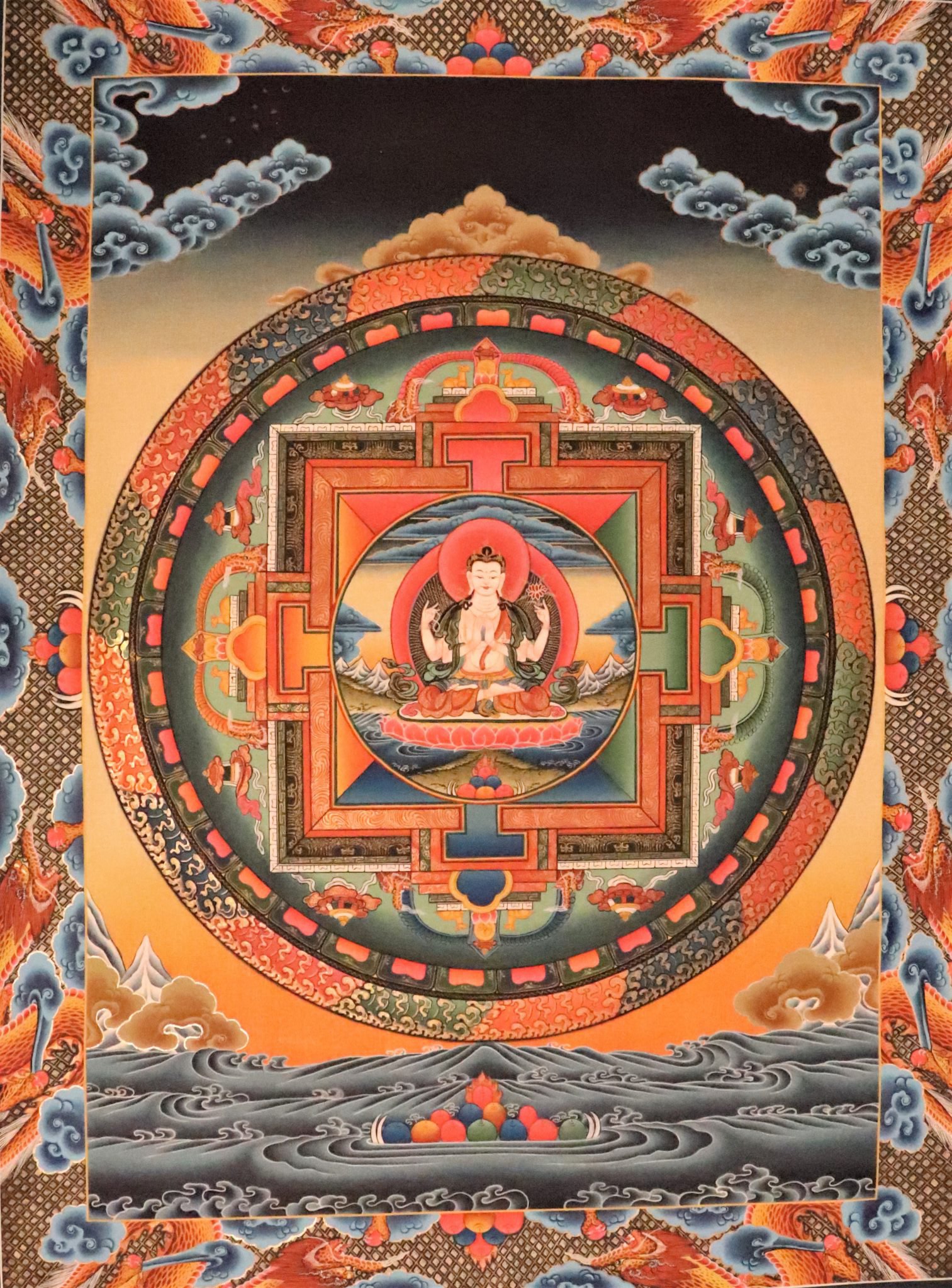

Chenrezig with White Tara Thangka
Chenrezig with white tara thangka is handpainted on cotton canvas by Thangka artist from Nepal. Chenrezig is also known as Avalokitesvara. Chenrezig is the most revered of all Bodhisattva embodying the compassion of all Buddhas.
Chenrezig is at the center of the thangka. Green Tara is depicted in the top right corner of the thangka above the Chenrezig. White Tara is presented in the top left corner above the Chenrezig. Amitabha Buddha is presented at the top of the Chenrezig in the painting. Two armed Mahakala is presented in the top-down corner of the Chenrezig. Two Armed Mahakala has two armed. He has three eyes. Manjushree is presented in the left down corner of the Chenrezig.
Iconography of Chenrezig
Chenrezig is visualized in many forms with various numbers of faces and arms, and various colors and ornaments. He sits on a lotus and the flat disc of the moon with another moon disk behind him, reflecting his total purity. Two of his four arms are joined in the prayer position holding the wish-fulfilling gem.
In his other left hand, he holds a lotus flower and in his other right hand, there is a crystal mala which he is using to count the repetitions of his mantra.
Mantra of Chenrezig
The Mantra of Chenrezig is Om Mani Padme Hum.
Iconography of Green Tara
Green Tara is also known as Samaya Tara. She is represented in a royal ease posture with her left leg bent her left leg overstepping the main lotus and resting on a blue lotus ready to get up and offer assistance to those in need.
She is portrayed with maroon Buddhist robes and jewelry. The earrings represent patience, understanding, and renunciation. The diadem with five jewels represents the transmutation of the five delusions into the Five Buddha Wisdoms. She is shown with a benevolent countenance seated upon a white moon disk which is associated with special restorative nectar associated with the naval chakra center.
Mantra of Green Tara
The mantra of Green Tara is om tare tuttare ture soha.
Iconography of White Tara
White Tara's embodiment of peace directed through loving compassion. From her serenity, she lends grace and dignity to situations and encourages the good to arise in all circumstances and situations.
The extra eye on her forehead, on the palms of her hands & the soles of her feet, represent her ability to see and understand the sufferings of all beings & her omniscient compassion toward the suffering.
Mantra of White Tara
The mantra of White Tara is Om Tare Tuttare Ture Mama Ayur Pune Gyana Puntin Kuru Swoha.
Iconography of Amitabha buddha
Amitabha is head of the Lotus Family, one of the oldest & significant of the Five Buddha Families. This family represents love, purity, compassion & peace. Amitabha Purelandis a place of infinite bliss & boundless light.
Amitabha Buddha is also one of the five Tathagatas representing the wisdoAmitabha Buddha is also one of the five Tathagatas representing the wisdom of discriminating awareness. Amitabha Buddha is red in color. He is represented in the stupa facing to the west. He rides on a peacock symbolizing that he can take away the suffering of others just as the peacock eats poisonous plants and yet his tail shines forth.
Mantra of Amitabha Buddha
The mantra of Amitabha Buddha is Om ami dewa hr.
Iconography of Manjushree
Manjushree is the Bodhisattva who holds the flaming sword of enlightenment, by his left hand in a warning hand gesture in the left hand representing his realization of wisdom to cut through ignorance & wrong view. His right hand depicted in teaching holds the stem of a Blue Lotus flower upon which rests the Book (Pustaka) of Perfection of Transcendental Wisdom.
Mantra of Manjushree
The mantra of Manjushree is Om A Ra Pa Ca Na Dhih.
Iconography of two armed Mahakala
Two armed Mahakala is presented in the top-down corner of the Chenrezig. Two Armed Mahakala has two armed. He has three eyes.
Mantra of two armed Mahakal
The mantra of Two armed Mahakala is Om Benza Nara Trim Trim Hung Hung Phet Phet Soha.











